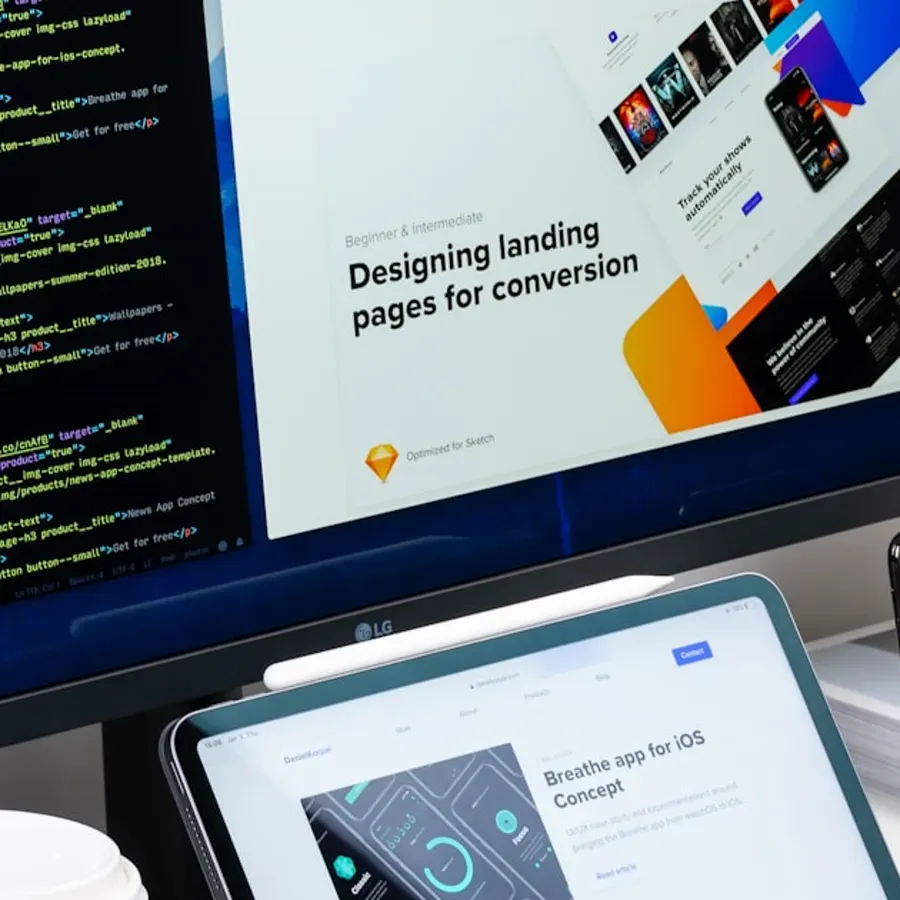
Why Responsive Design Is Essential in 2025
In today's digital landscape, the way people access websites has fundamentally shifted. Mobile devices now account for over 60% of global web traffic, with that figure climbing even higher in emerging markets like Vietnam, where mobile internet usage reaches an impressive 78%. This seismic shift in user behaviour means that having a responsive web design isn't just a nice-to-have feature—it's absolutely critical for business success.
Non-responsive websites face severe consequences in the modern marketplace. Studies consistently show that 53% of mobile users abandon sites that take longer than three seconds to load, and bounce rates on non-responsive sites can exceed 90%. Google's mobile-first indexing policy means that your mobile site performance directly impacts your search rankings, making responsive design a crucial SEO consideration. Beyond metrics, there's a simple truth: users expect seamless experiences regardless of whether they're browsing on a smartphone during their morning commute, working on a tablet at a café, or using a desktop computer in the office.
The business case for responsive web design extends far beyond user satisfaction. Companies with mobile responsive websites see significantly higher conversion rates, improved customer engagement, and better brand perception. In markets with high mobile penetration, businesses without responsive designs are essentially closing their doors to the majority of potential customers. The investment in responsive design pays dividends through increased revenue, reduced maintenance costs compared to maintaining separate mobile and desktop sites, and future-proofing your digital presence as new devices and screen sizes emerge.
Understanding the Fundamentals of Responsive Design
Responsive web design is built on three foundational pillars that work together to create adaptable, fluid experiences across all devices. First, fluid grids use relative units like percentages rather than fixed pixel values, allowing layouts to scale proportionally. Second, flexible images and media that resize within their containing elements prevent content from breaking layouts on smaller screens. Third, media queries enable CSS to apply different styles based on device characteristics like screen width, orientation, and resolution.
The viewport meta tag serves as the cornerstone of responsive design implementation. This simple line of HTML code—<meta name='viewport' content='width=device-width, initial-scale=1.0'>—tells browsers to match the screen's width in device-independent pixels and sets the initial zoom level. Without this tag, mobile browsers render pages at desktop widths and scale them down, defeating the purpose of responsive design entirely.
Modern responsive web design leverages CSS Grid and Flexbox as powerful layout tools. CSS Grid excels at creating two-dimensional layouts where you need precise control over both rows and columns, perfect for complex page structures. Flexbox shines in one-dimensional layouts, making it ideal for navigation menus, card layouts, and component-level responsiveness. Together, these technologies replace older float-based layouts and provide cleaner, more maintainable code that adapts naturally to different screen sizes.
The Role of Relative Units
Understanding and properly implementing relative units is fundamental to creating truly responsive designs. Percentages allow elements to scale based on their parent container, while viewport units (vw, vh) scale based on the browser window size. Em and rem units provide scalable typography and spacing, with rem units offering the advantage of consistent sizing relative to the root element. Using relative units throughout your design ensures that everything scales proportionally, maintaining visual harmony across devices from compact smartphones to ultra-wide desktop monitors.
Mobile-First vs Desktop-First Approach
The mobile-first approach to responsive web design has become the industry standard, and for compelling reasons. This methodology starts by designing and developing for mobile devices first, then progressively enhancing the experience for larger screens. The philosophy embraces constraints as creative opportunities, forcing designers to prioritise essential content and functionality. When you begin with the most limited screen real estate, you naturally focus on what truly matters to users.
Mobile-first development offers significant performance advantages. By loading core content and functionality first, then adding enhancements for larger screens, you ensure fast loading times for mobile users on potentially slower connections. This approach aligns perfectly with progressive enhancement principles, where the baseline experience works for everyone, and additional features enhance the experience for users with more capable devices and faster connections. In markets like Vietnam, where 4G and 5G adoption continues to accelerate but 3G connections remain common, this approach ensures accessibility for all users.
Conversely, desktop-first approaches often lead to bloated mobile experiences. When you start with a feature-rich desktop design and try to scale down, you face difficult decisions about what to remove or hide. This typically results in heavier page weights, slower loading times, and compromised mobile user experiences. The desktop-first mindset can also lead to responsive designs that feel like afterthoughts rather than intentional, optimised experiences for mobile users.
Implementing Mobile-First CSS
In practice, mobile-first CSS means writing your base styles for mobile devices, then using min-width media queries to add complexity for larger screens. This approach keeps your code organised and maintainable, with mobile styles as the foundation and enhancements layered on top. The result is cleaner, more efficient CSS that's easier to debug and maintain over time, while also providing better performance for mobile users who don't need to download and parse styles intended for larger screens.
Fluid Grids and Flexible Layouts
Fluid grids form the structural backbone of responsive web design, replacing fixed-width layouts with proportional sizing that adapts to any screen width. Rather than defining a container as 960 pixels wide, a fluid grid might set it to 90% of the viewport width, ensuring it scales naturally whether viewed on a 320-pixel smartphone or a 2560-pixel desktop monitor. This mathematical approach to layout ensures consistency and predictability across devices.
CSS Grid revolutionised responsive layout capabilities with its powerful two-dimensional grid system. Using properties like grid-template-columns: repeat(auto-fit, minmax(300px, 1fr)), developers can create grids that automatically adjust the number of columns based on available space, without writing a single media query. This intrinsic responsiveness makes CSS Grid particularly valuable for card-based layouts, image galleries, and complex page structures that need to adapt gracefully across screen sizes.
Flexbox complements CSS Grid by excelling at one-dimensional layouts and component-level flexibility. Navigation menus that stack vertically on mobile and display horizontally on desktop become trivial with Flexbox's direction and wrap properties. The flex-grow, flex-shrink, and flex-basis properties provide fine-grained control over how elements distribute space and respond to container size changes, making Flexbox indispensable for creating truly flexible interfaces.
Combining Grid and Flexbox
The most powerful responsive layouts often combine both CSS Grid and Flexbox strategically. Use Grid for overall page structure and major layout regions, then employ Flexbox within those regions for component-level responsiveness. This hybrid approach leverages each technology's strengths, resulting in layouts that are both robust and maintainable. Card components might use Flexbox internally for content arrangement, while Grid handles their distribution across the page.
Responsive Images and Media
Images represent the largest portion of page weight on most websites, making responsive image implementation crucial for performance. The fundamental technique involves setting images to max-width: 100% and height: auto, allowing them to scale down proportionally within their containers. However, truly responsive images go far beyond simple CSS scaling, addressing both art direction and performance concerns across different devices and screen resolutions.
The HTML picture element and srcset attribute provide powerful tools for serving different images based on device characteristics. Using srcset, you can specify multiple image files at different resolutions, letting the browser choose the most appropriate version based on screen size and pixel density. The picture element takes this further, enabling art direction where you might show a landscape-oriented image on desktop and a portrait-oriented crop on mobile, ensuring optimal composition at every screen size.
Lazy loading has become essential for responsive image performance, particularly on mobile devices with limited bandwidth. Native lazy loading using the loading='lazy' attribute tells browsers to defer loading off-screen images until users scroll near them. This significantly improves initial page load times, especially on content-heavy pages with numerous images. For critical above-the-fold images, omit lazy loading to ensure they appear immediately, maintaining perceived performance.
Modern Image Formats
Modern image formats like WebP and AVIF offer superior compression compared to traditional JPEG and PNG formats, reducing file sizes by 30-50% while maintaining visual quality. Implementing these formats with appropriate fallbacks using the picture element ensures broad browser support while delivering optimal performance to capable browsers. Image CDNs can automate format selection and optimization, serving the best possible image for each user's device and browser combination.
Breakpoints and Media Queries Strategy
Media queries serve as the conditional logic of responsive web design, applying different styles based on device characteristics. The most common media query targets screen width, but you can also query device orientation, resolution, hover capability, and other features. A typical mobile-first media query might look like @media screen and (min-width: 768px), applying styles only when the viewport exceeds tablet width.
Choosing appropriate breakpoints requires balancing content needs with common device sizes. Rather than targeting specific devices, modern responsive design establishes breakpoints where the content naturally needs to adapt. A common strategy includes a mobile base (320-767px), tablet range (768-1023px), desktop (1024-1439px), and large desktop (1440px+). However, these ranges should be adjusted based on your specific content and design requirements rather than treated as universal standards.
Avoid breakpoint proliferation by focusing on major layout shifts rather than tweaking every element at multiple sizes. Too many breakpoints create maintenance nightmares and bloated CSS. Instead, leverage flexible layouts, fluid typography, and intrinsically responsive techniques like CSS Grid's auto-fit and minmax functions to minimise the need for explicit breakpoints. Reserve media queries for significant layout changes that truly enhance the user experience at different screen sizes.
Testing Breakpoints
Testing breakpoints requires examining your design at various widths, not just at specific device sizes. Chrome DevTools' responsive design mode allows you to drag the viewport to any width, helping identify awkward states between breakpoints where content might break or look suboptimal. Real device testing remains crucial, as emulators can't perfectly replicate actual device behaviour, touch interactions, and performance characteristics.
Touch-Friendly Navigation and Interactions
Touch interfaces demand fundamentally different interaction design compared to mouse-based desktop experiences. Apple's Human Interface Guidelines recommend minimum touch target sizes of 44x44 points, while Google's Material Design suggests 48x48 density-independent pixels. These dimensions ensure that users can accurately tap elements without frustration, accounting for the inherent imprecision of finger-based input compared to mouse cursors.
Navigation patterns must adapt for touch-based mobile devices. The ubiquitous hamburger menu, while sometimes controversial, remains a space-efficient solution for mobile navigation when implemented properly. Alternative patterns include bottom navigation bars for frequently accessed sections, tab bars for app-like interfaces, and priority+ navigation that shows important items and collapses others. The key is ensuring navigation remains discoverable and accessible, with clear visual affordances indicating interactive elements.
Hover states present unique challenges in responsive design since touch devices have no hover capability. Designs should never rely solely on hover to reveal crucial information or functionality. Instead, implement touch-friendly alternatives like tap-to-reveal patterns, or simply show information persistently on mobile devices. Use media queries like @media (hover: hover) to apply hover effects only on devices that support them, preventing awkward stuck hover states on touch devices.
Form Optimization for Mobile
Mobile-responsive forms require careful attention to input types, labels, and layout. HTML5 input types like email, tel, and number trigger appropriate virtual keyboards on mobile devices, dramatically improving the user experience. Adequate spacing between form fields prevents accidental taps on the wrong input. Large, thumb-friendly submit buttons and clear error messaging ensure users can complete forms successfully on mobile devices, directly impacting conversion rates.
Performance Optimization for Mobile Devices
Performance optimization becomes paramount in responsive web design, particularly for mobile users who may be on slower connections or less powerful devices. The goal is to deliver fast, smooth experiences regardless of device capabilities. This requires a holistic approach addressing everything from code optimization and asset delivery to rendering performance and user-perceived speed.
Code splitting and lazy loading JavaScript ensure users only download code needed for their current view. Critical CSS inlining places essential styles directly in the HTML document, allowing above-the-fold content to render immediately without waiting for external stylesheet downloads. Defer non-critical JavaScript loading to prevent it from blocking page rendering. These techniques dramatically improve Time to First Byte (TTFB), First Contentful Paint (FCP), and other Core Web Vitals metrics that Google uses for ranking.
Asset optimization extends beyond images to encompass all downloadable resources. Minify CSS and JavaScript to reduce file sizes. Enable Gzip or Brotli compression on your server to further reduce transfer sizes. Leverage browser caching with appropriate cache headers so returning visitors don't re-download unchanged resources. Consider using a Content Delivery Network (CDN) to serve assets from geographically distributed servers, reducing latency for global audiences.
Monitoring Real-World Performance
Real User Monitoring (RUM) provides insights into actual user experiences across different devices, networks, and locations. Tools like Google Analytics can track page load times segmented by device type, helping identify performance issues specific to mobile users. Regular performance audits using Lighthouse and PageSpeed Insights highlight optimization opportunities and track improvements over time, ensuring your responsive web design delivers fast experiences consistently.
Testing Across Devices and Browsers
Comprehensive testing across devices and browsers ensures your responsive design works flawlessly for all users. Chrome DevTools provides an excellent starting point with its device emulation mode, allowing you to simulate various screen sizes, pixel densities, and network conditions. However, emulation has limitations—it can't perfectly replicate actual device rendering, touch behaviour, or performance characteristics.
Real device testing remains indispensable for validating responsive designs. Maintain a device lab with popular smartphones and tablets representing different operating systems, screen sizes, and capabilities. Test on older devices with less powerful processors to ensure adequate performance for all users. Pay attention to how designs render in different browsers—Safari, Chrome, Firefox, and Edge can display the same CSS differently, particularly for newer features.
Cloud-based testing platforms like BrowserStack and Sauce Labs provide access to thousands of device and browser combinations without requiring physical hardware. These services enable systematic testing across different configurations, screenshot comparison tools, and even interactive remote device access. Automated visual regression testing can catch unintended design changes across different breakpoints and devices, maintaining design consistency as you continue development.
User Testing and Feedback
Technical testing validates functionality, but user testing reveals how real people interact with your responsive design. Conduct usability testing sessions with participants using their own devices, observing how they navigate, where they struggle, and what they find intuitive. Analytics data showing high bounce rates on specific device types or screen sizes can indicate responsive design issues requiring attention.
Common Pitfalls and Solutions
Even experienced developers encounter common responsive design pitfalls. Fixed-width elements that don't adapt to smaller screens are a frequent issue, solved by using relative units and max-width properties. Content that's hidden on mobile devices for space-saving purposes may frustrate users who can't access important information—consider accordion patterns or collapsible sections instead of completely hiding content.
Typography challenges arise when text becomes too small to read on mobile devices or too large and overwhelming on desktop screens. Fluid typography using calc() and viewport units creates scalable text that adjusts smoothly across screen sizes. The formula calc(16px + (24 - 16) * ((100vw - 320px) / (1920 - 320))) scales font size proportionally between minimum and maximum values based on viewport width.
Navigation menus that work beautifully on desktop often become unwieldy on mobile devices. Dropdown menus with multiple levels create particularly difficult touch interactions. Solutions include simplified mobile navigation structures, dedicated mobile menus with flat hierarchies, and search functionality to help users find content without navigating complex menu structures.
Why Choose M&M Communications for Your Responsive Design Needs
At M&M Communications, we specialise in creating mobile responsive websites that deliver exceptional experiences across all devices. Our mobile-first development approach ensures your website performs beautifully whether visitors are using the latest smartphones, tablets, or desktop computers. We understand the unique challenges of the Vietnamese market, where mobile internet usage dominates and diverse device capabilities require thoughtful optimization.
Our comprehensive responsive web design services cover everything from initial strategy and user experience design through development, testing, and ongoing optimization. We implement industry best practices including fluid grids, flexible images, performance optimization, and rigorous cross-device testing. Our team stays current with evolving web standards and technologies, ensuring your website leverages the latest responsive design techniques while maintaining broad compatibility.
We don't just build responsive websites—we create digital experiences that drive business results. Our designs prioritise conversion optimization, ensuring that responsive layouts facilitate user journeys and encourage desired actions. We provide detailed analytics implementation and ongoing performance monitoring, giving you insights into how users interact with your site across different devices and identifying opportunities for continuous improvement.
Ready to transform your digital presence with a truly responsive web design that engages users and drives results? Contact M&M Communications today. Call our hotline at 0909 123 456 or email us at hello@mmcom.vn to discuss your project. Let us help you create seamless experiences that work flawlessly across all devices and position your business for success in our mobile-first world.






